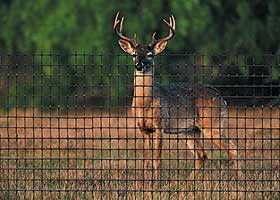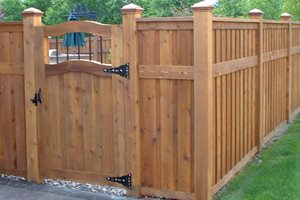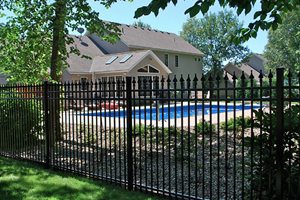Deer Fencing
Height requirements and design ideas for deer fences
A quality plastic deer fencing product starts at about twenty-cents per linear foot for the woven material itself. Into the fence estimate is added posts, hardware, and additional fasteners as well as gates and locking mechanisms.
Deer are at once beautiful and destructive. Where they exist in rural and suburban areas, they can devastate a landscape overnight. While there are so called deer-resistant plants, these will vary by region, and in times of little food deer will eat them too. Increasing populations of deer in some suburban areas has resulted in more aggressive food finding behavior which is why there can be some variations in just how high this fence must be to function properly during drought or exceptionally long winters.
There is a second way that deer can damage your landscape. Each year they rub the felt off new horns which can severely damage or even kill young trees and shrubs. Inevitably homeowners in deer country will be forced to come to terms with the deer problem if they want to enjoy a beautiful or productive landscape.
You May Also Like:
-
Front Yard Landscaping Video - See how this yard takes advantage of amazing views and uses water-wise and deer-resistant plants
-
Estate Landscape - How a coastal California property maximized its views and dealt with a deer problem
-
Deer Resistant Perennials - Discover 12 perennials deer are less likely to eat (from Proven Winners)
Some communities created to create a wildlife rich place to live prohibit deer fence, and in some cases, all fences to encourage an open range. It is important to determine if your neighborhood is under similar regulations before you put up a deer fence. Conservation agencies of the government may also have limitations set up around national parks, preserves and other managed wildlife habitat.
A good local landscape architect or site planner can help you better manage your landscape through specific design strategies. Those familiar with larger homesite design and local deer behavior are ingenious at devising ways to use deer fences so they are more limited and less visible. Remember, this fence is expensive to buy and install, and it must be maintained if aggressive hungry bucks decide to take it on with their antlers. A good strategy gets the job done for the least cost.
Certainly deer fencing can be built on a site-wide basis along the property boundaries, which is the most expensive option and also requires a deer-proof gate for your car to go in and out. To avoid the cost and inconvenience of a gated compound, focus first on the most plant oriented parts of the homesite such as a food garden or orchard.
Deer Fence Details
Deer can jump straight up and over a six foot fence, so any barriers must be at least 8 feet tall. However, in areas with extreme pressure for food or overly large populations of deer, there may be individuals that can jump higher than the norm. This height of fence must be able to stand up to wind, winter storms and snowfall, which is what contributes to the expense. To lower materials costs there are some contractors installing electrified fencing like that used in livestock pens. These can be driven by solar powered units, but these too have their shortcomings and may be illegal in some communities.
-
Pro Tip:
I recommend an eight foot fence, or if there are height restrictions, double fences spaced four or five feet apart work well.
- Stephen Suzman, Suzman Design Associates in San Francisco, CA
HooverFence.com offers deer fencing online. "We recommend a minimum of 7’ high fence for deer fence. The cost averages as low as $0.20 a linear foot when purchasing economy fencing in quantities of 5,000 linear feet or greater. Note that this price is for the net alone and excludes posts, cables, gates, and accessories. Our economy deer fence is to be used chiefly as a sight-deterrent fence, whereas our standard product line has significantly more strength built into it."
Before spending a great deal on deer fencing, consider these important points to discuss with your contractor:
- Do I really need to fence the entire property? If so, will I have to put a gate on my driveway?
- Can I manage with only certain areas protected?
- Is there a deer fence design that allows smaller wildlife to come and go while deer stay out?
- Will such a significant barrier impact the overall beauty of my landscaping?
- Are there any government or community regulations that prohibit deer fencing?
Here are some other tips:
- Construct your deer fencing before you plant your garden or landscape.
- Install deer proof gates because they will find the low point and go over.
- Fence must be flush with the ground since deer may try to squeeze under too.
Newer Strategies
In recent years there have been experiments with deer fencing based on the fact that they jump high, but they seem reluctant to jump over broader, wide barriers. With this in mind some have found success with these unusual alternatives on smaller scale applications, but due to the variability of deer species and regional behaviors, they may not be successful where you live. Discuss with your fencing contractor to be sure.
Option 1-
Two shorter T-post and woven wire field fences are built three feet apart, running parallel to one another. This is close enough to make a single fence unit and wide enough to prevent them from going over. The elimination of ten foot fence posts and anchoring alone will reduce the cost of this alternative significantly.
Option 2-
Another way to create a similarly wider barrier is a bit more challenging but equally effective. Known as a cantilever deer fence, the posts are made of wood in the shape of an upside down 'L'. The top piece is at least three feet long which requires a diagonal support. Woven wire fence is laid over the top of the horizontal pieces to create a barrier as wide as the parallel fences without sacrificing so much space. While more difficult to build, it requires only half the materials of the double fence.

 Backyards
Backyards
 Front Yards
Front Yards





